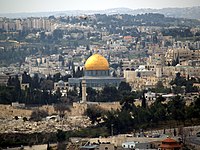User:TwoHorned/work under way 1
| 280px Jamal and Muhammad al-Durrah filmed by Talal Abu Rahma for France 2 | |
| Date | September 30, 2000 |
|---|---|
| Time | circa 15:00 hours (Israel Summer Time); noon GMT |
| Location | Netzarim junction, Gaza Strip |
| First reporter | Charles Enderlin for France 2 |
| Filmed by | Talal Abu Rahma |
| Casualties | |
| Reported deaths: Muhammad al-Durrah; Bassam al-Bilbeisi, an ambulance driver; and an unnamed jeep driver | |
| Jamal al-Durrah reported with multiple gunshot wounds. | |
| Suspects | Israel Defense Forces, Palestinian National Security Forces, Palestinian gunmen |
| Convictions | None |
The Muhammad al-Durrah (Arabic: محمد الدرة) incident took place in the Gaza Strip on September 30, 2000, and refers to the controversies generated from the death of a young arabic palestinian child aged 12, Mohammed al-Durrah, and from the broadcasting by France 2 of a footage voiced over from France 2 journalist Charles Enderlin. According to Charles Enderlin[1], Mohammed al-Durrah was killed very likely from bullets of Israeli origin, while his father was tying to protect him, during crossfire between Israeli soldiers and Palestinian security forces.
Shortly after the killing of Muhammad al-Durrah, a few people in France (Gérard Huber, Stéphane Juffa, then Philippe Karsenty, Luc Rosenzweig) initiated and supported what has been characterized as a "campaign"[2][3] that began by casting doubt on whose bullets killed Muhammad al-Durrah, and culminated in allegations that the entire incident was staged using fake ambulances and actors. Described by French magazine Mediapart as "a sophisticated machine"[4] with "many iterations",[5] it has involved several court cases. Underpinned by political and ideological motives,[6][7][8][2][9], it is backed by radical pro-Israeli political actors.[10].
Genesis of the controversies
[edit]September 30, 2000
[edit]
On September 30, 2000, two days after Ariel Sharon's visit on the Temple Mount in the Old City of Jerusalem and second day of Second Intifada, amidst widespread violence across the West Bank and Gaza Strip, journalists from Reuters, Associated Press, NHK and Talal Hassan Abu Rahma, a Palestinian cameraman freelancing for France 2 and who has been working with France 2 journalist Charles Enderlin for more than 20 years[1] have taken place at the Netzarim junction in the Gaza Strip[6]. The Netzarim junction, known locally as the al-Shohada (martyrs') junction after the Palestinians who have died there in clashes with Israeli soldiers, lies a few kilometers south of Gaza City (at 31°27′54″N 34°25′36″E / 31.465129°N 34.426689°E).[11] The source of the dispute at the junction was the nearby Netzarim settlement where—until Israel's withdrawal in 2005—60 Israeli families lived; they were allowed to enter and leave the settlement only with a military convoy. An Israeli military outpost, Magen-3, guarded the approach to the settlement, and had been the scene of a series of violent incidents in the days before the shooting.[12]

Mohammed al-Durrah, a 12-year-old boy, along with his father, Jamal al-Durrah, enter Al-Shohada Street and take the direction of the Netzarim junction: there is no school that day, because of the strikes and protests in the palestinian territories[13]. Jamal (born c. 1966) lived with his wife Amal and their seven children in the UNRWA-run Bureij refugee camp in the Gaza Strip. Jamal was a carpenter and house painter who had worked for Moshe Tamam, an Israeli contractor, for 20 years. Israeli writer Helen Schary Motro came to know him when she had employed him to help build her house. She wrote in 2000 of his years of rising at 3:30 am to catch the bus to the border crossing at four, then a second bus out of Gaza so he could be at work by six. The border was closed on the day of the incident because of the rioting, which is why Jamal was not at work.[14] Muhammad (born 1988) was in fifth grade. Father and son decided instead to go to a car auction, according to an interview Jamal gave Abu Rahma in hospital the day after the shooting.[15]
... to be continued...
See also
[edit]Notes
[edit]- ^ a b Charles Enderlin, Un enfant est mort, Don Quichotte editions, Paris, 07/10/2010, ISBN 978-2-35949-026-8.
- ^ a b Guillaume Weill-Raynal, Les nouveaux désinformateurs, Armand Colin, 2007.
- ^ Dominique Vidal, « Au nom du combat contre l'antisémitisme,», Le Monde diplomatique.
- ^ François Bonnet, « Charles Enderlin : Dix années de traque, et ce n’est pas fini », Mediapart, October 11, 2010.
- ^ Jérôme Bourdon, « Qui a tué Mohammed el-Dura ? De la mise en doute informatique d’un fait journalistique : Paroles publiques : Communiquer dans la cité », Hermès n° 47, 2007, p. 92.
- ^ a b Hervé Deguine, Charles Enderlin. Il gagne la guerre du soupçon, Médias (11), décembre 2006, online version. Cite error: The named reference "media20061211" was defined multiple times with different content (see the help page).
- ^ Guillaume Weill-Raynal, La communauté juive française, la seconde Intifada, et « l’affaire Al Doura », Confluences Méditerranée numéro 72, numéro sur "La Palestine en débat", pp. 75-82. ISSN 1148-2664, ISBN 978-2-296-10418-1, L'Harmattan, Paris.
- ^ Dominique Vidal, « Acharnement contre Charles Enderlin », Le Monde diplomatique, 29 mai 2008.
- ^ Isabelle Hare, Le rêve brisé de Charles Enderlin: transposition du conflit israélo-palestinien devant les locaux de France 2 in XVIIe congrès international des sociologues de langue française, Actes de travaux du groupe de travail "Sociologie de la communication", Tours, 5-9 juillet 2004, France, pp. 166-174, [1].
- ^ Anne Brigaudeau, Charles Enderlin raconte dix ans de harcèlement, culturebox, November 9, 2010, (in french).
- ^ Stack 2003.
- ^ Goldenberg, October 3, 2000; CNN September 27, 2000.
- ^ Orme, October 2, 2000.
- ^ Schary Motro 2000.
- ^ See Abu Rahma 2000.
Template:Featured article is only for Wikipedia:Featured articles.
